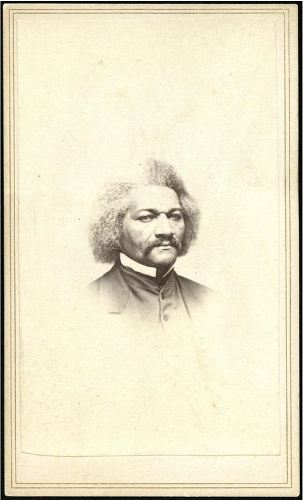By Steve Thornton
The great abolitionist Frederick Douglass had significant ties to Connecticut. He visited Hartford many times, spoke to appreciative crowds, and dined with elected officials. Douglass had his portrait taken by a local photographer and his autobiography published in 1882 by Hartford’s Park Publishing Company. (The Life and Times of Frederick Douglass became so popular it went through four printings.) Hartford’s Reverend James Pennington, himself a fugitive from “slave justice,” even officiated Douglass’s wedding in Philadelphia. Douglass had not always been so popular in this state, however, and today his Connecticut presence has faded.
Frederick Douglass Escapes Slavery
In 1838 Douglass escaped from slavery in Maryland after knocking down brutal “slave breaker” Edward Covey in self defense. Douglass fled to the relative safety of New Bedford, Massachusetts. After a series of jobs (and a life spent constantly looking over his shoulder) he began speaking publicly against slavery alongside well-known abolitionists such as William Lloyd Garrison.
During an 1845 trip to England aboard a Cunard steamship, the ship’s captain asked Douglass to speak on the promenade deck. No sooner had Douglass begun than a hostile “Connecticut Yankee,” who bragged he owned many slaves, began heckling him. Southern passengers then chimed in and a fight broke out with Douglass supporters. The ship’s captain ended the melee by ordering three sets of chains prepared for the instigators. The captain revealed that he, too, once owned slaves, but due to the efforts of abolitionists like Douglass, he freed them.

Detail from a letter written by Frederick Douglass to the Boston Liberator from the Victoria Hotel, Belfast, Jan. 1, 1846 and reprinted in The Charter Oak, February 12, 1846.
Frederick Douglass did not find his first trip to Hartford very welcoming either. He and his comrades “found several towns in which people closed their doors and refused to entertain the [idea of assisting them],” he wrote in Life and Times. “Notably among these were Hartford, Conn., and Grafton Mass. In the former [we] determined to hold our meetings under the open sky, which we did in a little court under the eaves of the ‘sanctuary’ ministered unto by the Rev. Dr. [Joel] Hawes, with much satisfaction to ourselves and I think great advantage to our cause.” The site of this speech was the First Congregational Church of Hartford.
As time went on, and the pro- and anti-slavery debate sharpened, Frederick Douglass gained greater popularity. In October 1854 he was in Chicago to rebut the pro-slavery rhetoric of Stephen A. Douglas. An anti-slavery Hartford newspaper reported on the visit, exclaiming “the Black Douglass against the White one! Who can doubt as to the result!” The senator from Illinois, nicknamed “the little giant,” later debated Abraham Lincoln in 1858 and then lost the 1860 presidential election to him.
Connecticut Denies Blacks the Right to Vote
After Union victory in the Civil War, the black freedom struggle continued. In 1865 Connecticut voters overwhelmingly rejected giving African Americans the right to vote. Just one town, Meriden, supported voting rights for black people in that referendum. Frederick Douglass went on to address the people of Meriden in 1868. Despite racist treatment by Steven Ives, the landlord of the Meriden House where Douglass stayed, the speech was very well received.
Connecticut’s struggle with much of its pro-slavery past remains a topic of controversy to this day. Ironically, present-day Hartford has a memorial plaque commemorating a speech by Stephen Douglas at the corner of Main and Pearl Streets. There is no corresponding memorial for Frederick Douglass.
Steve Thornton is a retired union organizer who writes for the Shoeleather History Project









